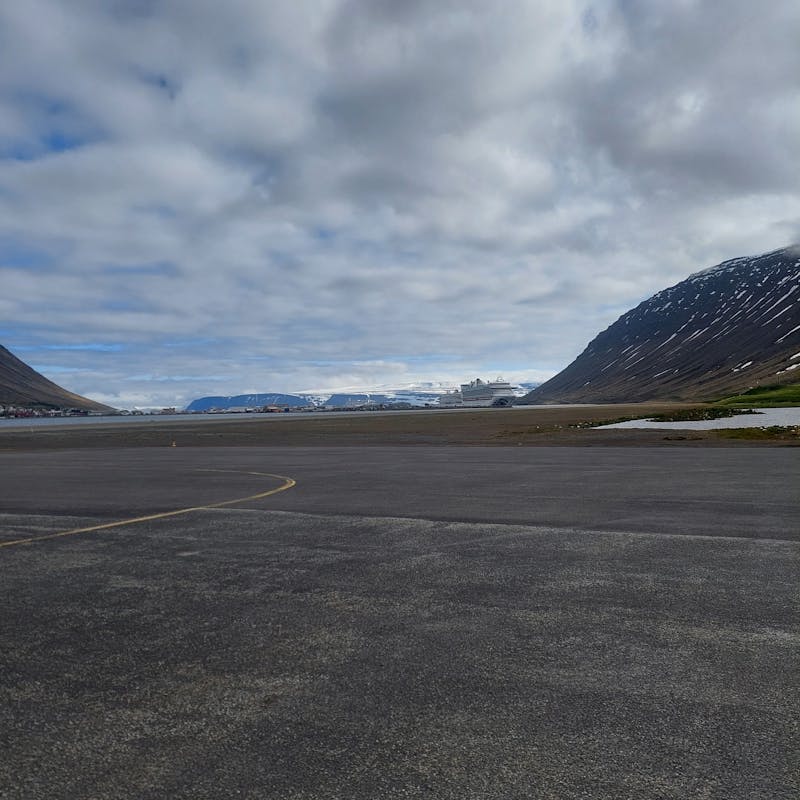Air and Geometric Flair
Iceland is an island, surrounded by water, whose first human inhabitants arrived by boat in the ninth century. Boats and maritime connections are of particular interest to me, and I am visiting to learn more about these in the Arctic. I travel, however, by plane, from the Alps to Reykjavík International Airport, then from Reykjavík Domestic Airport to Ísafjörður and the Westfjords of Iceland. Alice Saunier-Picard, in an “Arctic Chronicle” written in 1968, underlined the extent to which aviation had revolutionized transportation on the island:
“A mostly mountainous country, mainly frozen and barren, with a jagged coastline, communities scattered over small coastal towns and isolated farms, its economy long stifled by the Danes’ market monopoly, Iceland, until the beginning of the twentieth century was deprived of roads and railway lines. It was short of ships for inshore navigation, while inland mobility took place exclusively on small horses.”
The development of air transportation in the twentieth century, and in particular the appearance of the first commercial jet airliners in the 1950s, transformed human movement on a global scale. Connections within and out of Iceland also improved significantly.
“Air transport in Iceland has increased dramatically: it compensates for the island’s isolation regarding the European and American continents as well as inland distances through glaciers and lava fields.” (trans. Françoise Décugis)
Vintage advertising by Icelandair shows spectacular sceneries, such as the rocky profile at the old Parliament fields, dramatic waterfalls, or emphasizes routes to Europe and North America. This strategy appears to have worked, as in Reykjavík today, it’s hard not to notice tourists who stop to jump in a hot spring on their way to or back from Europe or the Americas.
The airport in Ísafjörður is nicely tucked in the pit of Skutulsfjörður, and throughout my stay there, I will come to appreciate the landing and take-off of the local Icelandair plane on the one runway that is Ísafjörður airport. The arrival and departure board in Reykjavík indicated several destinations: Akureyri, Bíldudalur, Hornafjörður... Groups of business people mingled with hiking folks in the lounge, on their way to some similarly convenient runways.
In the well-illustrated Saga flugvalla og flugleiðsögu á Íslandi by Arnþór Gunnarsson (2018), bird’s eye views of local airports throughout the island repeat a geometrical motif: one, sometimes two perfect grey lines (in which case it’s a cross), on green grass and blue sea. In the 1950s and 1960s, when these airports were built, this concrete design was mirrored by a generation of abstract painters, such as Hörður Ágústsson, Benedikt Gunnarsson, Valtýr Pétursson, and Þorvaldur Skúlason. The most striking, if equally mysterious analogy, might be with the textile variations of such geometrical abstractions, as practised by artists such as Ásgerður Búadóttir.
The use of the grid was seen by the art historian Rosalind Krauss from its development in cubism to the abstract currents of the 1950s and 1960s as announcing “modern art’s will to silence, its hostility to literature, to narrative, to discourse... ”, its capacity “in walling the visual arts into a realm of exclusive visuality and defending them against the intrusion of speech” (R. Krauss “Grids”, October 1979). Without wishing to oppose the clear trajectory of introspection that the use of the grid implies in the history of modern art, its parallel proliferation in air transportation, city planning, and for better or worse planetary transformation points, in a complementary design, more to a flourishing of narratives.





